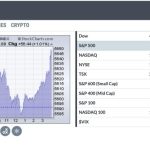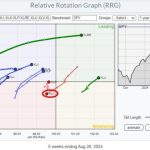In the world of finance, certain sectors often experience rallies that drive their values to new highs, prompting investors to assess the sustainability and potential risks associated with these upward trends. One such sector that has recently experienced significant growth is the Financial Select Sector SPDR Fund (XLF). Despite achieving new highs, there are looming concerns regarding whether XLF may be heading for a substantial decline.
It is crucial to understand the factors driving the surge in XLF’s value before delving into the potential risks that investors should be aware of. Several underlying dynamics have contributed to the fund’s ascent, including positive economic data, increased investor confidence, and rising interest rates. These factors have collectively propelled financial stocks, which are prominent components of XLF, to outperform other sectors in recent months.
Additionally, the investment landscape has been influenced by the Federal Reserve’s monetary policy decisions, particularly its approach to interest rates. As the Fed gradually increases rates in response to a strengthening economy, financial institutions stand to benefit from higher margins and increased profitability. This favorable environment has bolstered XLF’s performance, attracting investors seeking exposure to the financial sector’s growth potential.
However, despite the optimistic sentiment surrounding XLF, there are potential pitfalls that investors should consider. One key concern is the possibility of a market correction triggered by unforeseen events or external shocks. Given the interconnected nature of financial markets, a downturn in one sector could have cascading effects on others, potentially leading to a broad market decline.
Moreover, regulatory changes and geopolitical uncertainties represent additional risks that could impact XLF’s performance. Regulatory shifts, such as changes in banking legislation or increased oversight, could constrain financial institutions’ activities and profitability. Similarly, geopolitical events, such as trade disputes or geopolitical tensions, have the potential to disrupt global markets and dampen investor sentiment towards financial stocks.
Another factor to monitor is the level of leverage within the financial sector. High levels of debt could amplify losses in the event of a market downturn, as seen during previous financial crises. Investors should assess the leverage profiles of individual companies within XLF to gauge their vulnerability to adverse market conditions.
Furthermore, technological advancements and innovations in the fintech space pose a competitive threat to traditional financial institutions. Disruptive technologies and changing consumer preferences could reshape the financial sector landscape, potentially displacing incumbent players and reshuffling industry dynamics.
In conclusion, while XLF has reached new highs driven by favorable economic conditions and rising interest rates, investors should remain vigilant of the potential risks that could lead to a significant downturn. By monitoring market dynamics, regulatory developments, leverage levels, and technological disruptions, investors can make informed decisions to navigate the uncertainties ahead and manage their exposure to the financial sector effectively.



